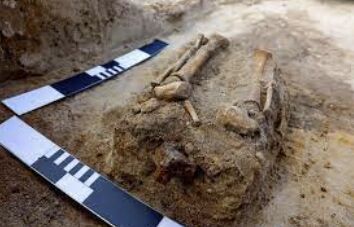Archaeological Breakthrough: Revenant Remains Unearthed in 17th-Century Poland, Shedding Light on Proto-Zombies
Archaeologists in Poland have unearthed the remains of a suspected vampire child, providing evidence of the existence of revenants in the 17th century. The discovery sheds light on historical beliefs and burial practices surrounding the undead.
Archaeologists in Europe have made a groundbreaking discovery that provides physical evidence of the existence of revenants, a term used to describe proto-zombies, in 17th-century Poland. The remains of a suspected child revenant, often referred to as a "vampire child," were found in an unmarked mass cemetery near the Polish city of Bydgoszcz. The child, believed to be around 6 years old at the time of death, was buried face down with a triangular iron padlock placed under its left foot. This was likely an attempt to bind the child to the grave and prevent it from haunting its family and neighbors.
Lead archaeologist Dariusz Polinski explained that the padlock would have been locked to the child's big toe. The grave was desecrated at some point after burial, and all the bones except for those of the lower legs were removed. This unique burial position ensured that if the child tried to rise from the dead, it would bite into the dirt instead. The excavation also uncovered the remains of three other children in a nearby pit. A green stain found in the mouth of one of the children was chemically analyzed and shown to have traces of gold, potassium permanganate, and copper, possibly indicating the use of a potion to treat the child's ailments. The cause of death for both the child and the woman's remains found nearby remains unclear.
Historian Martyn Rady explained that while the child and woman may not fit the traditional definition of vampires, they do fall under the category of revenants. The term "vampire" was first defined in the 1720s by Austrian officials who encountered suspected vampires in what is now northern Serbia. Polish legends feature two types of revenants – the upior and the strzyga. The upior, similar to Dracula, feasted on the living, while the strzyga was a malevolent female spirit or demon that preyed upon humans and drank their blood. The tradition of placing padlocks in graves was a common practice in Central Europe, particularly in Poland, during the late Middle Ages.
It remains unclear why the woman and child were singled out for this ritual. Some theories suggest that social stigmas such as being unbaptized, dying by suicide, exhibiting strange behavior while alive, or being the first to perish in an epidemic could have contributed to their burial treatment. During times of epidemics, communities would search cemeteries for the "patient zero" and disinter multiple corpses to prevent further spread of diseases.
Lack of decomposition in the bodies was often seen as a sign of revenancy. To prevent further deaths, graves were sometimes desecrated, with the bodies being buried face down, beheaded, or having limbs cut off. Objects made of iron, thought to possess anti-demonic powers, including padlocks and sickles, were placed in the graves as preventive measures. If all else failed, the bodies would be removed and burned, with the ashes being scattered or submerged.
While the treatment of these supposed revenants may seem gruesome, the belief in their existence provided closure for the communities in question. As Bela Lugosi's Dracula famously stated, "To die, to be really dead, that must be glorious." The discovery of these remains provides valuable insights into the cultural and historical context of the time, shedding light on centuries-old beliefs and practices regarding the undead.




